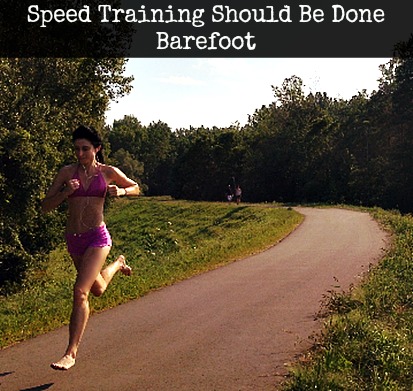Running barefoot proved to be important in engaging safer forefoot running mechanics during speed training as compared with cushioned running shoes.
As it turns out, running barefoot stimulates the feet most directly which makes it easier to uphold adaptable and functional connections in the form of a low-impact forefoot strike, stable ankle, knee and hip mechanics, as well as a safer upper body posture! Basically, you’re always at your mechanical best when your feet are close to the ground AND your feet can feel the ground.
Sadly, research shows that many runners in cushioned heeled running shoes have difficulties landing correctly on their forefoot, and in many cases, mistakingly heel strike and produces greater-than-normal impacts. This is why cushioned running shoes are pegged as a mechanical interference because the lack of ground-feel compromises the brains feedback loop, which is why these shoes continuously undermine your stride control.
Case in point, a study in the Journal of Sports Science found that running speed did not affect foot strike pattern in barefoot and shod (shoe) runners in that barefoot runners maintained a forefoot strike at faster speeds, whereas shod runners maintained a heel strike at faster speeds. But, as expected, the heel strike runners produced the greatest impact forces and loading rates than the barefoot runners.
- This also means that during speed training, shod runners have a greater risk of overuse injury than forefoot striking-barefoot runners
Always remember that whether you’re running fast or slow, proper stride coordination entirely relies on your feet’s ability to feel the ground, but in a running shoe with excessive cushioning, your feet are reflexively less responsive, which is why the foot wrestles with the ground too much. However, this doesn’t mean you to have to abandon your cushy running shoes because the more you practice barefoot running, the more your motor nerves change with the experience, the more the barefoot running mechanics become hardwired in your muscle memory, the easier it will be for you to uphold these mechanics when you chose to run in cushier shoes!

Read more here about all the other evidenced-based reasons barefoot running makes you a better shod runner!
References:
Jimenez-Munoz et al. Influence of shod/unshod condition and running speed on foot-strike patterns, inversion/eversion, and vertical foot rotation in endurance runners. J Sports Sci, 2015;33(19):2035-2042.

Bretta Riches
BSc Neurobiology; MSc Biomechanics candidate, ultra minimalist runner & founder of RunForefoot. I was a heel striker, always injured. I was inspired by the great Tirunesh Dibaba to try forefoot running. Now, I'm injury free. This is why I launched Run Forefoot, to advocate the health & performance benefits of forefoot running and to raise awareness on the dangers of heel striking, because the world needs to know.
Latest posts by Bretta Riches (see all)
- Can You Run In Barefoot Shoes? Yes, But DON’T Heel Strike! - 21/07/2024
- Why Cushioned Running Shoes Are Really Bad for Your Feet - 19/07/2024
- Do Cushioned Running Shoes Cause Injuries? - 17/07/2024



